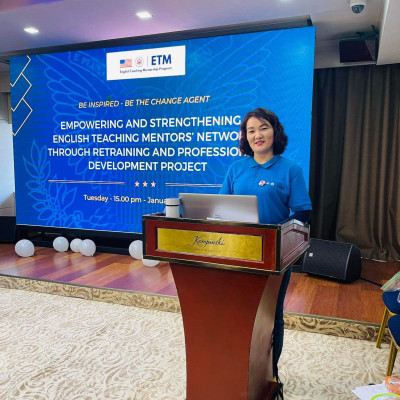Sessions / Do not record or livestream this session
Cancelled Barriers and Motivators: Vietnamese Working Adults' use of Graded Readers #4089
Extensive reading has become an increasingly important aspect of language teaching due to its numerous advantages. Observationally, Vietnamese people have not had reading habits, making it more challenging for working adult learners to engage in extensive reading. This study aims to examine working adult learners’ perceptions of graded readers and their motivation to integrate them as homework outside the classroom. Data were collected through a questionnaire and individual interviews with a diverse group of 100 adult learners, ranging from Generation X to Generation Z. Additionally, in-depth interviews were conducted with 15 participants, including 5 from Generation X, 5 Millenials, and 5 from Generation Z. The findings revealed differences in the levels of preference for graded readers across the three generations and identified key obstacles they encounter when engaging in extensive reading. To address these challenges, this study presents students' suggestions and proposes strategies to enhance the effectiveness of extensive reading.
Embedding ER as Core Content in LMS CollegePathway and Academic Express 3 #4470
CollegePathway and Academic Express 3 are LMS platforms built on supereigo.com that support multiple English learning goals including TOEIC, EIKEN and university entrance exams. They are used by over 100 institutions across Japan and serve hundreds of thousands of students and teachers. In April 2025, we added Pearson Bank, a repository of 30 graded short stories ranging from abridged classics to original Pearson titles. Each story is accompanied by in platform vocabulary, grammar and comprehension exercises so that extensive reading becomes part of both the student learning experience and the teacher toolkit. This presentation describes the integration process including curriculum alignment and workflow embedding. We examine three months of log data to understand how teachers and students incorporate story reading and how story use aligns with overall platform engagement. This case offers a scalable model for embedding graded extensive reading as a central measurable component of language learning on large scale digital platforms.
Extensive Reading and Media Representation in Discourse Analysis #4239
Considering the significance of critical thinking skills in Discourse Analysis, this study explores the effectiveness of reading, particularly in analyzing the representation of the former Indonesian President Joko Widodo. Before engaging in discussion and paper writing, 20 sixth-semester intermediate English students read two 1,000-word newspaper articles weekly for five weeks on post-presidency activities. This task aims to enhance their critical reading skills, expose them to varied discourse strategies, and provide a rich foundation for discussion. After the discussion, students complete a questionnaire assessing the impact of reading on analytical engagement and discourse comprehension. Preliminary findings suggest that the task aids in identifying linguistic patterns, contextual influences, and ideological framing in media texts, leading to more nuanced discussions and deeper analytical insights. Utilizing a qualitative research method, this study highlights the role of reading in fostering critical thinking and discourse competence, reinforcing its value as a pedagogical tool in discourse analysis courses.
Extensive Reading and the Development of Speaking Skills #4069
This presentation highlights the value of extensive reading as a resource of comprehensible input for ESL and EFL learners and its myriad benefits for the development of their language and speaking skills. It examines classroom observations from case studies of two experienced English teachers and shares their practices to develop Primary 5 students’ extensive reading and listening skills to hone their knowledge of the sounds, words and structures of English. Teachers’ modelling of extensive reading and listening and thoughtful design of speaking tasks helped students to improve their content and language. The scaffolded practice enabled students to use the speaking structures to participate in interactions right away, adapting the ideas from classroom talk. Finally, the presentation concludes with a discussion of the implications for instruction and teachers’ important roles in creating conducive environments in class to model and promote extensive reading to enhance students’ language and speaking skills.
Student Engagement with Free Chosen and Assigned Books in an ER Course #4071
This study investigated an Extensive Reading (ER) implementation in a university classroom. It involved the first-semester students who read a combination of the same graded readers at different levels and self-selected books based on their preferences. The study focused on students' engagement and progress on the combination as well as on group dynamics in the classroom. The data collection included students’ reading logs, group work results, and students’ feedback. By analyzing student feedback and individual and group reading engagement data, the study found that most students participated in the group reading and enjoyed the combination of two types of book choices. However, some challenges such as book availability, demotivated students, and students’ reading speed were still present.
From Concept to Classroom: Writing Graded Readers #4112
In this session the presenters will discuss the process of writing graded readers from an initial idea, to writing and editing, and to finally getting the books into the hands of students in both paper and digital formats. Where do stories come from? How do we ‘find’ stories and tell them in an engaging and interesting way? We will detail the steps that have worked for us — from ‘story,’ format, length, level, editing and illustrations, to publishing steps and options, including ISBN numbers — all while trying to keep abreast of the rapid advancement of online tools. Mistakes have been made and lessons have been learned. We share where we are today in this journey in the desire to support burgeoning writers.
University English Conversation Students’ Voices on Extensive Listening #4111
Extensive listening (EL) has been widely used for exposing students to the target language. Numerous studies have discussed the effects of EL to improve students’ listening skills; however, a few concentrate on how EL affects speaking skills. This research investigated EL potential in developing students’ English-speaking skills. 24 Indonesian university students’ were exposed to EL by listening to one graded e-book and recording their thoughts related to the audio file for one semester. Data, coming from students’ weekly EL log assignments and online open-ended questionnaires, were analyzed quantitatively and qualitatively. Thematic analysis was used to analyze the data. Results show that most students have benefited from EL in terms of expressing ideas, improving fluency, and developing confidence. Additionally, all students agree to include EL as one supporting activity in the conversation class. Overall, students’ EL experiences and EL effect on their English speaking skills will be discussed in the presentation.
Boosting Emotional Growth and Reading Motivation with Digital Narratives #4076
Digital storytelling is a pedagogical approach aimed at enhancing students' motivation, critical thinking, learning outcomes, and socio-economic development. Recent studies indicate its effectiveness in teaching English as a second language to forty-five tertiary learners, assisting in mitigating negative emotions such as shyness and fear of speaking, embarrassment in classroom settings, and lack of confidence when using English in social contexts. Students were randomly divided into eight independent groups. The four controlled groups were taught the basic use of PowerPoint to digitalize their bilingual storybooks. Other groups were granted the autonomy to create a digital storybook outside the classroom using other Apps such as CapCut or Canva. Flipping the classroom has proven to be an effective strategy for encouraging verbal expression while also fostering trust and connection among group members. The digital narratives effectively engaged learners, enhancing their motivation to read and understand the content.
From Pages to Habits: Student’s Journey in an Extensive Reading Course #4122
The study examines the impact of an Extensive Reading (ER) program for first-year English Department students at a tertiary education institution in Indonesia. Research has found that developing independent reading habits is crucial in foreign language learning, yet many first-year English department students struggle to transition from required reading to self-directed reading for pleasure. To address this challenge, ER is integrated into the curriculum as a compulsory course for first-year English department students. The case study investigates how a one-semester ER course influences the reading habits and experiences of a cohort of first-year students. It examines data from 150 students, using ER self-reflection reports, reading history logs from the digital platform Xreading, and interviews to gain information on the evolution of the student's reading habits. The expected findings will reveal patterns in their reading habits, challenges they encounter, and the role of the digital reading platform in shaping their experiences.
Writing Skills and Vocabulary Gains through ER in a Teacher Training Course #4135
Students enrolled in the second year of an elementary school teacher training course read extensively over a three-month period (once a week for 45 minutes x 9). The results of an English writing test (fluency, syntactic complexity, syntactic accuracy, lexical complexity) and a vocabulary survey (150 questions in total, 30 each at the 1000-, 2000-, 3000-, 4000-, and 5000-word levels) conducted before and after the extensive reading program showed no significant growth in writing skills, but significant growth in vocabulary was observed at the 1000-word level, the 4000-word level, and in total. The reflections written by the participants after the 3rd, 6th, and 9th lessons were analyzed qualitatively, and the factors behind the quantitative results were analyzed and implications will be discussed based on these results.
Interest, Attitude, and Confidence in Reading: Researching Online ER #4396
Do you know what topics your first-year university students in Japan are interested in? How about their reading habits or self-confidence in reading? Research has suggested that positive emotions toward reading (Zhou, 2024), along with positive attitudes and habits, facilitate student engagement in an Extensive Reading (ER) curriculum. A study was launched in April 2024 to examine how first-year Japanese university students navigate a year-long online extensive reading curriculum. In this poster session, the presenters will discuss student responses that may inform educators integrating online extensive reading into their courses. They will present initial findings on students’ reading interests, habits, self-confidence, and emotional responses to reading. These results establish a baseline for evaluating the impact of two consecutive semesters of online extensive reading on students' engagement and confidence.
A Study on How Basic Polysemous Words Are Used in Extensive Reading Books #4146
Extensive reading encourages learners to read materials that are easy and accessible, often containing basic vocabulary. Many basic words, particularly verbs and prepositions, are polysemous and are understood in cognitive linguistics as having a “central” meaning along with multiple “extended” meanings. This study examines how the central and extended meanings of basic polysemous words are presented in graded readers and leveled readers, comparing them with formal English textbooks used in junior and senior high schools in Japan. Focusing on several basic words (e.g., break, make, run, and take), this study analyzes their usage and provides insights into how extensive reading materials and textbooks can be utilized to foster a more comprehensive understanding of these words.
Enhancing Students’ Interest and Management Skills in Extensive Reading #4408
This poster presents strategies for engaging a diverse group of 80 students with different English proficiency levels in extensive reading. It explores how motivation influences students' reading habits, book preferences, and overall confidence in language learning. Interactive activities, such as role-playing and poster-making, have been integrated into the program to foster active participation. Through acting performances, students improve their speaking, comprehension, pronunciation, and teamwork skills. These techniques make learning more enjoyable and effective, especially for young beginners. As a result, many students have developed a daily reading habit and sustained practice, leading to noticeable progress in their language skills. By fostering interest and engagement, these approaches not only help students improve their English but also empower them to become lifelong readers and future leaders. This presentation highlights practical ways to create an engaging extensive reading experience that encourages continuous learning.
Can ER Contribute to the Development of Output Skills? #4132
Numerous studies have been conducted to prove the efficacy of extensive reading (ER). The majority of them have revealed the impact of ER on receptive skills. How can ER affect productive skills? This presentation explores what aspects of ER could possibly influence the acquisition and retention of controlled productive vocabulary. Sixty-two English majors at a private university in Japan who experienced ER for 13 months participated in the study. They took the Productive Vocabulary Levels Test at the 2,000-word level 3 times: at the start of ER, toward the end of the second semester, and in the beginning of the third semester following the school closure due to the COVID-19 pandemic. The findings from statistical tests and analyses of the participants’ reading records will be discussed. Pedagogical suggestions will be offered to conclude the presentation.
Regression Analysis of Longitudinal ER on Writing Fluency in High School #4115
Extensive reading (ER) often requires years to give students sufficient text exposure. However, maintaining student engagement over such a long period is challenging. As a result, studies extending beyond a year are rare. Keeping students motivated is crucial, and providing opportunities to recognize progress can help sustain engagement. This study explores the relationship between two years of reading volume and a one-year academic writing course in a Japanese high school. Using regression models, this study examines trends over time and shows that reading amount significantly predicts words written. This prediction enables learners to set small goals for progressing in reading, fostering improvements in writing fluency. Celebrating small successes supports long-term language development. While this study highlights the link between ER and written word count, future research should examine accuracy and language use to further reinforce the reading-writing connection.
Analysis of Books Used by Young EFL Learners Preparing for ER #4372
Based on a longitudinal study of 10 young Japanese learners who continued reading books for 6 to 14 years, eventually progressing to reading paperbacks for L1 teenagers, this study conducted a lexical and non-lexical analysis focusing on the books they used during their elementary school years to find out why they found certain books difficult. The data used in the analysis were taken from Reading AtoZ (levels aa to H) and Oxford Reading Tree (stages 1+ to 7), which they used until they moved on to graded readers for adult beginners. Reading AtoZ level aa books were mostly covered by known vocabulary and vocabulary they could associate with the illustrations. As the levels progressed, the number of words that were difficult to associate with the illustrations increased. It has been found that the books often reported difficult are due to lexical factors, irregular syntactic structures and unknown contextual backgrounds.
Supporting Students' Reading Skills in Rural Areas with E-Library Resources #4421
In rural areas, students face significant challenges in developing their English language skills due to limited opportunities for participation in extracurricular programs, clubs, and circles. These constraints restrict their ability to engage in additional learning and growth. However, the X-Reading e-library provides a valuable solution by offering a platform that allows students to improve their English skills at their own pace. This digital library gives students access to books tailored to their language level and personal interests, fostering a love of reading while enhancing comprehension and vocabulary. Furthermore, the platform encourages active involvement from parents and guardians, enabling them to track their child’s progress and support their learning journey. By integrating the X-Reading e-library into rural education, students gain the opportunity to develop their English language skills independently, fostering more equitable learning opportunities and promoting lifelong learning.
'The kind of girl who eats pizza': Gender Representation in Graded Readers #4156
Research into the pedagogical benefits of Extensive Reading has bloomed in the last decade, yet socio-cultural content of ER materials has not received similar attention. While there is a significant body of literature related to gender in ELT textbooks, research into gender representation in English-language graded readers is nearly non-existent. The presenters worked to address this gap through a collaborative, two-pronged study of English graded readers. A set of narrative fiction readers and another of non-fiction readers, including titles from several publishers, were selected while considering relevance in the researchers' teaching context. The researchers examined and coded the visual and textual content in the selected readers for gendered representations and used content analysis to build a description of each set, then compared and contrasted the respective data. This session will present the findings in detail, explore the implications for instructors and ER programs, and note further avenues for related research.
From Foreign to Familiar: Making Graded Readers for Thai Learners #4139
Graded readers are essential for language acquisition, but their effectiveness depends on quality stories, linguistic accessibility, and cultural relevance. While many graded readers exist, few are tailored to specific local cultures. Many stories are based on Western norms, which may not resonate in non-Western countries. This presentation focuses on developing graded readers for Thai learners of English, considering their cultural perspectives, reading preferences, and linguistic challenges. Drawing from a project funded by The Fundamental Fund, Thailand Science Research and Innovation (TSRI), the session explores narrative styles, familiar themes, cultural frameworks, interests, and vocabulary needs that align with Thai sensibilities. It also discusses how the materials from this project align with the Thai National Curriculum to enhance motivation and comprehension. The session provides practical insights for educators, publishers, and curriculum designers looking to create engaging and culturally sensitive reading materials.
Bringing Graded News and World Topics into the Classroom #4081
Living in the “24-hour news cycle”, whether through traditional news sources or social media, we can easily keep up with important issues from around the world. Literature on using news in ESL/EFL classrooms suggests that news stories can be used to develop leaners’ reading, writing and speaking skills (Tafida & Dalhatu, 2014), However, resources for language learners can be limited. One resource that does provide news stories written with graded language is Xreading News. This is a collection of five current news stories, written at the CEFR B1 level and published weekly on Xreading. This session will introduce Xreading news, discuss how it is created each week, and suggest some ways it can be used in the classroom. Presenters will also show graded readers featuring world topics. Books written in an engaging and accessible way, which provide students with the language needed if they are to discuss real world issues.
Extensive Reading Strategies Preferred by University Students #4390
This research aims to provide educational suggestions by analyzing extensive reading strategy preferences of Japanese university students. Extensive reading was incorporated in an English class to enhance their English proficiency. The students read books from the library for the first 20 minutes of every 90-minute class. Subsequently, a questionnaire was conducted with 16 students, employing a five-point Likert scale. The questionnaire was based on the top 10 principles proposed by Day & Bamford (2002), which were originally written for teachers but were modified in terms of students. As a result, the most favored principles were reading easy materials, choosing what they want to read and reading for general understanding. Although modeling is generally considered an effective learning strategy, the teacher as a role model of a reader was the second least favored principle. Finally, teachers should introduce those preferred principles earlier in class, creating a learning environment to realize them.
ER Activities Activate EFL Learners' Language Learning Strategies #4096
In compulsory EFL courses with adopted textbooks, graded reader activities promote extensive reading (ER), enrich the language curriculum, and enhance interactional communication skills (Kato, JANET 2024). Further teacher observations and class surveys showed that ER activities (sustained silent reading, book talk, writing book reports) substantially activate language learners’ “direct and indirect learning strategies”(Oxford, 1990), resulting in learners gaining a more positive outlook on studying English. They learn to adapt various effective language-learning strategies, which include cognitive (recognizing formulas and patterns, repeating, translating), metacognitive (paying attention, self-monitoring), compensation (guessing intelligently, using linguistic clues), memory (gesturing to convey new words, using keywords), social (asking questions, cooperating), and affective (encouraging oneself, enjoying speaking). This poster presentation discusses the ER practices in the first-year Japanese university EFL courses, focusing on how language learners navigate their language learning strategies in relation to ER tasks to enhance their English language communication skills.
Graded Readers' Coverage of Kyotsu Test Entrance Exam #4100
Despite evidence supporting its effectiveness, Extensive Reading (ER) is still not widely adopted, particularly in Japanese high schools, where teachers unfamiliar with ER have expressed concerns about cost, limited class time, and its effectiveness. One possible reason for this hesitation is the perceived lack of transfer to performance on university entrance exams. However, the English section of the Japanese Common Test for University Admissions (Kyotsu Test) is designed to assess reading and listening skills as they apply to real-world communication. Fluent comprehension of relatively simple texts is now an integral part of the exam, suggesting that ER could be an effective preparation method. This poster presentation examines the test’s question formats and reading passage characteristics. Additionally, it explores how the vocabulary and syntax profiles of several popular ER book series align with the Kyotsu Test reading passages by compiling and analyzing a corpus of test passages and graded readers.
Strategies for Goal Achievement in ER: Student Recommendations #4131
In ER, teachers often need to set goals and deadlines to ensure that their students are reading on a regular basis (O’Sullivan, 2012). To understand how students achieve these goals and provide guidance for future learners, 11 students in an elective extensive reading and listening course were asked to give future students advice on various aspects of meeting weekly targets. The questions, based on Griffith's (2018) strategy framework, focused on planning, resource selection, comprehension monitoring, and motivation maintenance. Findings revealed that perceived effective strategies varied among students. However, many students emphasized selecting books related to their interests and planning when to do the weekly assignments as important for achieving their goals. This presentation will describe the course, discuss highlighted strategies, and conclude with research limitations and future directions. This presentation will be of interest to teachers who are seeking ways to support their learners in achieving their reading goals.
Global Readers in Gobi #4142
Implementing extensive reading programs in rural areas presents unique challenges, but Khanbogd soum in Mongolia has successfully integrated Xreading across its secondary schools. This poster showcases how local leadership and community collaboration contributed to the program's success. With full financial support from the governor and local officials, all students from Year 6 to 12 were granted access to Xreading, ensuring equal learning opportunities. A mentor-mentee system was also established, where experienced Khanbogd 1st School students guided Khanbogd 2nd School students in adopting the program. This peer-supported approach facilitated smoother implementation and enhanced student engagement. Currently, Khanbogd 2nd School is awaiting the governor’s funding to officially launch Xreading. Our aim is to inspire other rural communities to build sustainable extensive reading programs through strategic partnerships and peer mentoring. This case study demonstrates that, with strong advocacy and local government support, even remote areas can cultivate a thriving reading culture.
Challenges in Translating English Graded Readers for L2 Japanese Learners #4401
In this presentation, we will share the experiences we gained while translating 30 graded readers for elementary-level L2 English learners into Japanese. The readers we translated are from the Cengage Foundations Reading Library series. Our work went beyond simple translations; it involved carefully adjusting lexical choices and sentence structures to ensure that each translated book was appropriately graded for its target audience of L2 Japanese learners. The framework we used is based on a widely used Japanese language textbook, GENKI: An Integrated Course in Elementary Japanese. Specifically, we divided Genki’s 23 lessons into 6 levels according to its vocabulary and grammar lists, and translated the 30 books into one of these 6 levels. Japanese extensive reading materials are limited in number, but translating from English graded readers could greatly expand availability, offering learners more diverse and accessible content.
Zero to Hero: Writing an Award Winning Graded Reader with NO Experience #4031
The idea of writing a book is something many of us consider, but know it is daunting. We start with a great idea and then quickly talk ourselves out of it. I’m busy. I don’t know where to start. Slowly, the great idea fades away. In this poster presentation, the author of the award-winning graded reader, ‘Identity’, will outline the process undertaken to write the story from scratch, with no previous writing experience. He will cover why and how ‘Identity’ was written, the process of writing, editing, levelling, and some of the factors contributing to it receiving a Language Learner Literature Award from the Extensive Reading Foundation and then becoming motivated to write a second graded reader. This poster presentation format will give participants ample opportunity to ask questions, discuss their own ideas and experiences and hopefully, become motivated to start writing their own original stories.
The Effects of ER on Reading Attitudes: A Review of the Research #4091
This presentation discusses a systematic review of research on the effects of extensive reading (ER) on reading attitudes in primary, secondary, and tertiary level language learning contexts. The review covered approximately 30 studies published from 1997 to 2024. Eligibility criteria for studies included using a clearly defined ER approach, implementing ER for a minimum of 10 weeks, and having a between groups and/or a pre/posttest design to be able to assess changes in reading attitudes due to ER. Based on the results of relevant questionnaire-based studies, it was found that ER had positive effects on aspects of learner reading attitudes such as reducing reading anxiety and improving levels of comfort and self-confidence. Specific practices and learning conditions such as the availability of a wide range of books, doing post-reading activities, and increasing the time doing ER were also found to be effective in fostering positive reading attitudes.
Windows Into Successful Graded Reading: Interviews With Engaged Students #4090
Many educators include graded reading in their courses based on research evidence outlining the potential to improve learner motivation (McLean & Poulshock, 2018) and develop language learning (Grabe & Stoller, 2019; Nation & Waring, 2019). Winning over reluctant readers poses a challenge. However, insights into what caught the interest of readers putting in the most time and effort in a reading project have merit. This session shares student-approved, case study statements covering past experiences, recent success with graded reading and MReader quizzes, and future reading. While not all learners see the light, better understanding the lived experience of these readers provides a window into the potential to engage other learners by process, texts, and support. The two-fold aim is to inform teachers for their practice but also to reward these students with an opportunity to share their reflections in live, recorded, and transcribed interviews in English at an academic conference.
中国广泛阅读实践与案例分享交流 (PERC交流会) #4471
1. PERC:英语广泛阅读的发展和市场变化 2. 一线老师关于泛读实践的案例分享 3. 讨论交流
Four Practical Tools to Add to the ER Teacher's Toolkit: A Workshop #4244
While appropriate difficulty and compelling content are essential for extensive reading, “linked skills activities” (Nation, 2024) that incorporate students` reading can further enhance learner engagement in coursework. This workshop aims to introduce four tools to use with ER and provide teachers with actual practice and takeaway materials. Reading Circles (Furr, 2009) include unique roles for students to address in discussions on common reading texts. Six Hats Thinking is a structured discussion format where participants first adopt a shared perspective before exploring others and can be used for selecting books. Mini-Bibliobattle is a 3-minute oral book report competition where attendees share their different favorite books and Q&A sessions decide a champion title. ER with Audio Support explains how reading-while-listening is key for development in young learners where novice readers decode words with phonics using audio/visual cues to aid comprehension. The sessions will share guidelines for instruction and feedback, and student reactions.
Learners' Materials Selection Methods and Criteria in Xreading #4101
Extensive reading researchers have previously identified a number of factors used in selecting texts, including difficulty level (Nation and Waring, 2020; Takase, 2007), length (Nishizawa, et al., 2010; Robb and Kano, 2013), personal interests (Yamashita, 2013), and initial impression of the cover and title (Bamford and Day, 2004). This research identified methods and information learners use within Xreading. A convenience sample of 32 university students in Japan required to use Xreading were surveyed anonymously. An equal percentage of responses indicated always using the filtering function as those always simply scrolling through the automated offerings (34% each), while 19% indicated always using the search feature. Further details, including results regarding use frequency for all filtering categories and perceived usefulness of all types of information available in each book's description will be presented and discussed. Implications for how instructors guide students in selecting materials and related research possibilities will also be discussed.
Sustaining ER in Low-Resource Communities: The Case for Nepal and Indonesia #4064
The presenter will first share their experience in ER teacher-training programs in schools in Nepal and Indonesia. Both countries share challenges including low literacy levels in home environments; economic hardship; diverse L1 backgrounds in which minority languages often have an oral tradition; and unsupportive institutional environments (Chaudhary, 2024). These factors have hindered the establishment of not only a robust reading culture but also in sustaining and cascading ER practices, particularly when there is a dearth of reading resources and libraries necessary for building a school reading culture (Loh, et al. 2017; Sharma, 2024). This will be followed by a look at two communities where ER has been successful due to the perseverance of individuals that believed in its efficacy. The success seen in initial reluctant reader groups will be shared based on their testimonials over a 5-year period. Their initiatives might serve as models for sustainability in low-resource communities.
Graded Readers: What is available publisher by publisher #4121
Until relatively recently few publishers, mostly the larger ones, published graded readers. However, in recent years there has been an explosion in the number of books available. Big companies, small companies and individual writer/publishers are producing some excellent books in graded format. These books cover a wide range of genres, such as adventure, romance, mystery, and non-fiction, to appeal to all types of reader. They are available at different levels, in different formats and wordcount. So, how do we know which books we can use in tandem with other classroom content? How do we recommend books to students? How can we create themed assignments? In this session, the presenters will give a brief, informative overview of the different series available by publisher giving participants a clearer idea of what is available in this market.
International Students' Reactions to Extensive Reading at a Japanese University #4141
As the population of 18-year-olds declines in Japan, the number of international students has increased in recent years. This presentation focuses on the impact of ER on international students enrolled in a range of EFL courses at a Japanese university from 2020 to 2024. Sixty-four students from 10 countries participated in 17 classes with Japanese peers. Since 2020, X-Reading has been used online in ER classes, while paper books in others. The reading target varies by class (native books for a fluent student). The presenter will show the reading amount, the series and tasks/activities they liked, and the results of the C-Test. She will include the data on their educational backgrounds and motives for taking English classes. The results from the comprehensive class survey have provided positive support for implementing ER linguistically and/or affectively. Overall, ER conducted in a globalized learning environment created synergy for the international and Japanese students.
Ideas to Access Materials: A Summary of Solutions to ER's Biggest Problem #4438
In this moderated session, the scholarship recipients who received funding to support their attendance at ERWC7 will share solutions to some of the main problems associated with ER. Common challenges including limited awareness of ER in training on pedagogical approaches, rigid curriculum and institutional policies, and a lack of localized research evidence all hamper initiatives to implement ER. Although these are significant hurdles, it is only with access to suitable materials that ER/EL/EV can be introduced and delivered effectively to move forward in addressing these challenges. The success in grassroots classrooms and institutional programs depends on teachers having interesting, level-appropriate, graded materials for their learners. Drawing from their experience and summarizing a range of presentations at this Congress, the panelists will share examples of resources available and novel methods being taken to overcome this primary limitation. Participants will be able to add and take away valuable ideas.

















































